The DOE Petition for Healthy Lighting
Petition for Rulemaking for a New Product Class of General Wellness Light Bulbs
In a retrograde move, the US Department of Energy (DOE) in April 2024 issued a final rule that, unless we take action, will ban most healthy light bulbs effective June 25, 2028, and will firmly cement the dominance of unhealthy blue-pump LED light bulbs.
On March 31, 2025, over 200 Americans submitted a formal petition for rulemaking to the DOE. The text of the petition appears below or you can click on the button to read a PDF version of it.
The Honorable Chris Wright
Office of the Secretary of Energy
U.S. Department of Energy
1000 Independence Ave. SW
Washington, DC 20585
cc:
Samuel Walsh
General Counsel
U.S. Department of Energy
1000 Independence Ave. SW
Washington, DC 20585
Pursuant to the Administrative Procedure Act, 5 U.S.C. § 553(e), the undersigned persons and organizations respectfully submit this petition for rulemaking. We request that the Department of Energy (DOE or Department) begin a new rulemaking process to define a new product class, pursuant to 42 U.S.C. §6295(q), for general wellness light bulbs.
Consumers need a new product class for general wellness light bulbs that can produce circadian-friendly light, near-infrared light, and other forms of healthy lighting. The requested proposed new product class would not be subject to the 2024-04-19 Energy Conservation Program: Energy Conservation Standards for General Service Lamps (GSL); final rule (125 lumens per watt rule or 125 L/W rule <sup>1</sup> ) but would still be subject to the energy efficiency standards in “the 45 lumens per watt (‘L/W’) backstop requirement for general service lamps [GSL] that Congress prescribed in the Energy Policy and Conservation Act, as amended.” 2
The shift in lifestyles makes healthy indoor lighting more important
In 1900, 41% of American jobs worked outdoors on farms; now, it’s only 1% 3 . In today’s world, the average person spends 93% of their time indoors under highly processed artificial light that fails to provide the health benefits of natural sunlight. 4
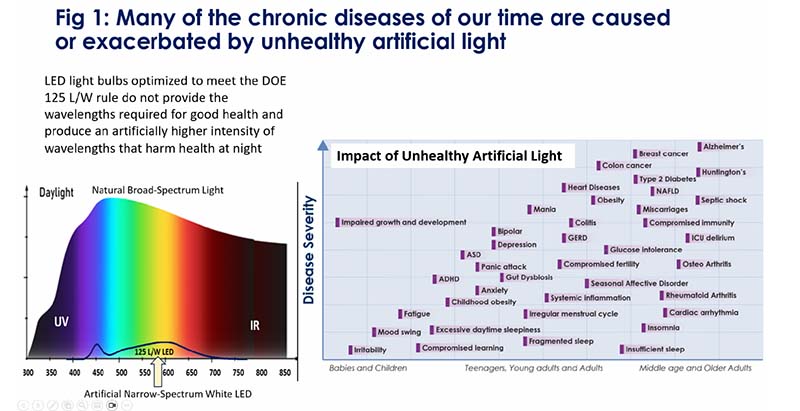
People who spend the most time outdoors daily are far healthier and live longer than those mostly confined indoors. This has now been repeatedly shown in large-scale studies tracking daily light exposure and the health of tens of thousands of people 5 . Furthermore, most chronic disease deaths at higher latitudes occur during winter when solar exposure levels are at their lowest, and the public spends more time indoors. 6
Unfortunately, the ultra-processed visible light that will be produced by GSLs under the 2024-04-19 Energy Conservation Program: Energy Conservation Standards for General Service Lamps (GSL); final rule (125 lumens per watt rule or 125 L/W rule 8 ) will substantially harm human health. Thus, a new product class is essential to provide consumers with a choice in lighting that provides health benefits for their families. It will also allow schools to provide lighting to optimize the health of their students and faculty and businesses to provide similar benefits for their employees and customers. The healthy lighting enabled by the product class is especially important for children and those unable to venture outdoors, such as the ill, the injured, or the elderly.
Blue-Rich Light at Night Causes Major Health Disorders
Blue light in the 440-495 nm waveband synchronizes circadian clocks during the day. However, exposure to the same 440-495 nm blue-rich light during evening and nighttime hours causes medically significant circadian disruption 9 . Such circadian disruption contributes to a wide range of neurologic, psychiatric, carcinogenic, metabolic, cardiovascular, allergic, and immunologic disorders. 10 Practically, LED lighting, under the 2028 rule change, often has no dimming or limited dimming. The inability to mimic day/night dimming range compared to incandescent and hybrid approaches further aggravates circadian disruption.
Near-Infrared Light Is Essential for Human Health
There is growing evidence that the current LED GSLs are a factor in increasing levels of metabolic diseases in the population and have other harmful effects on health.
The enemy of longevity is chronic disease, such as heart disease, diabetes, obesity, and many more. These diseases are all emblematic of mitochondrial dysfunction. 13
Inside most of your cells, there are organelles called mitochondria. They burn fuel in the form of glucose, fats, and proteins to make energy and carbon dioxide. Like a car’s engine, it needs a sound cooling system; otherwise, the engine will become inefficient and even shut down. Similarly, in the process of making energy, mitochondria also generate oxidative stress, which can make the mitochondria less efficient and reduce energy output, leading to mitochondrial dysfunction and chronic disease.
However, numerous studies have found that melatonin is made inside the mitochondria to mitigate oxidative stress. It functions as a kind of cooling system. The higher the level of melatonin, the less oxidative stress, which allows your mitochondria to work more efficiently. 14 15 16
Recent research shows that you can improve melatonin in your cells by exposing your body to the Sun, specifically red light and near-infrared light. Near-infrared light (NIR) is invisible to the human eye but can penetrate deep inside the body. Such light likely produces melatonin, the most potent antioxidant in the human body, in mitochondria.
A New Product Class Is Necessary
Besides the physiological impact, creating a new product class will increase innovation and investment in U.S. companies to design and manufacture this new class of products.
The DOE is apparently unaware of this science showing the link between light and health and thus has failed to propose a rule on its own for such a product class, leading us to submit this petition.
A broad range of different types of lighting used to be allowed by law and regulation, such as incandescent, halogen, and LED. The law and regulations inadvertently eliminated bulbs that can provide light beneficial to health. This is because the minimum lumens per watt standards only look at the visual brightness of a light and not its health-giving properties.
As illustrated in Figure 2 below, the perceived visual brightness of a light source for the average human is measured in lumens based on the 1924 V(λ) luminosity function, which is heavily weighted by green and yellow wavelengths with very little input from blue and red (and none from UV or NIR). In contrast, natural light from the sun contains a much broader range of visible and invisible wavelengths from ⁓300 nm to ⁓3000 nm, each of which provides specific health benefits.
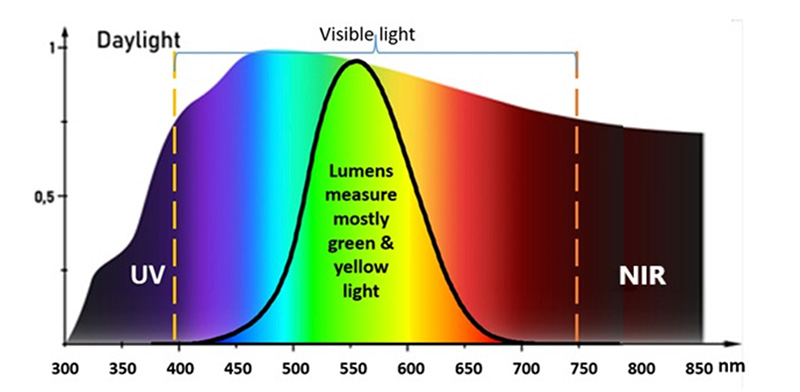
Unfortunately, in 2024, DOE went even further by adopting the 125 L/W rule. As a result, virtually all light bulbs available in 2028 will become narrow-spectrum blue pump LEDs. That rule will effectively make unavailable the manufacture and sale of light bulbs in 2028 that can provide healthy lighting in an energy-efficient way. American consumers desperately need access to a class of general wellness light bulb products.
What you can see in Figure 3 below is that the type of blue-chip LED light that can meet the 125 L/W rule for light bulbs has a very artificial and limited light spectrum. It has no ultraviolet or violet light, relatively little sky-blue light, very little red, and no near-infrared. It does have relatively more green and yellow wavelengths because those are required for human vision, but they are at much lower levels than we see outdoors.
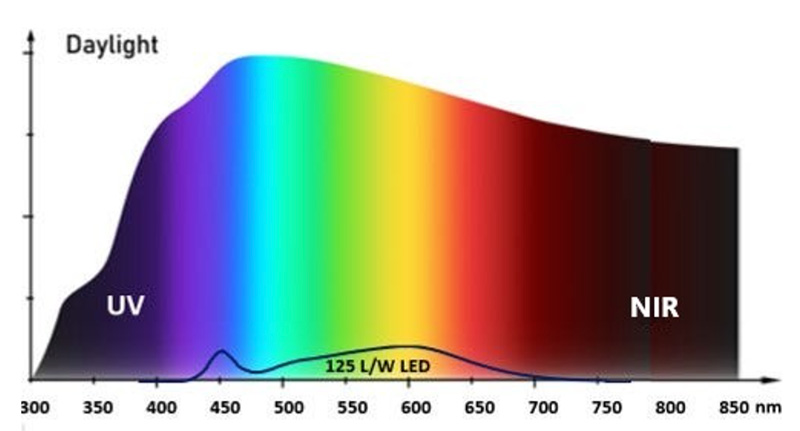
A wide range of wavelengths across the natural solar light spectrum deliver specific types of non-visual health benefits in addition to the value they may have in enabling color vision.
Table 1 shows an example of the peak effective light wavelengths for different biological functions of light. None of these color wavelengths other than 555 nm green is accurately represented by the lumens value of the light source, or by the lumens per watt electrical efficiency metric used in the current standards. The 125 L/W rule regulates lamps based on their “lumens per watt,” or luminous efficacy, which ignores the healthy (or unhealthy) properties of a light source. However, this rule only regulates the energy efficiency of providing the green and yellow wavelengths that determine the visual brightness of light measured in lumens (Fig 4). The rule does not reflect the energy efficiency of delivering most of the light wavelengths that promote human health.
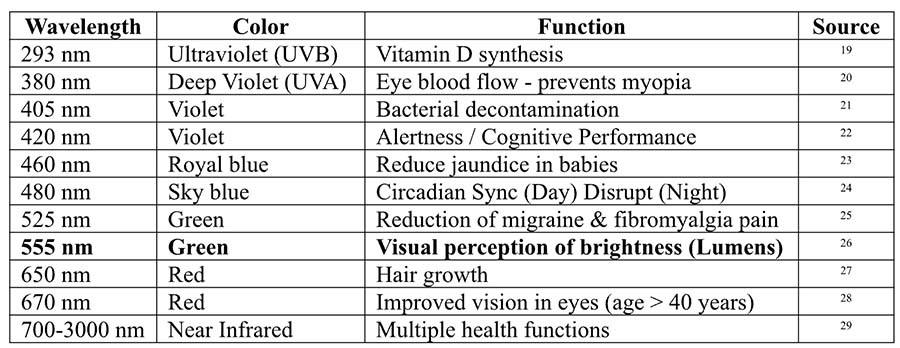
Table 1: The most biologically effective light wavelengths for different health benefits. Note that the only function reliably measured by Lumens is the visual perception of brightness. Thus, the Lumens metric does not indicate the healthiness of a light source 30 .
The only lights available under the current 125 L/W rule are blue-chip LEDs with a narrow artificial spectrum that is associated with ill health when used at night and do not provide adequately healthy light during the day.
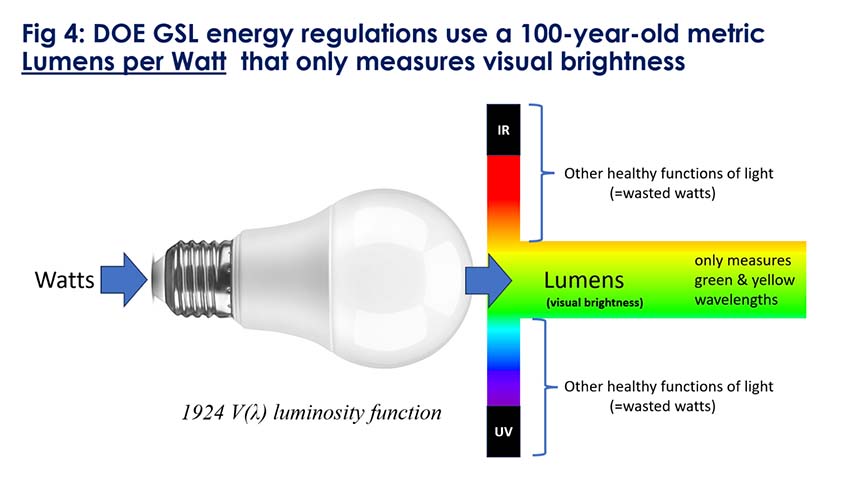
According to the U.S. Environmental Protection Agency, in its own words, “Simply put, energy efficiency means using less energy to get the same job done 31 . Our proposed product class would do just that, use less energy to get the job of providing healthy light done.
Permitting the production and sale of GSL bulbs that provide healthy lighting would provide enormous health benefits for all Americans. We reiterate that under our proposed product class GSLs would still meet the statutory requirements for energy efficiency of 45 lumens per watt, providing a 75% or more energy use reduction compared to incandescent GSLs.
If DOE fails to provide the proposed new product class, it will set in motion an unprecedented public health experiment on over 330 million unwilling Americans who would have no way to opt out by purchasing general wellness light bulbs. As consumers become increasingly aware of the lack of availability of healthy light bulbs, they will likely buy exempted products, such as rough service or appliance light bulbs, or a black market will develop. Creating a new product class that provides healthy energy-efficient lighting is likely to save energy and improve health.
The Department needs to quickly establish the proposed new product class to enable, or at least allow, the restoration of a minimum level of near-infrared light essential for human health and the production of circadian-friendly GSLs. We propose that DOE consider a definition for the General Wellness Lamp product class that appears in Appendix I.
The science examining the impact of light on human health is continuously growing in often surprising ways. A flexible and relatively simple rule for general wellness light bulbs will greatly encourage the lighting industry to invest in research to determine the most energy- efficient ways to provide healthy lighting.
The Trump Administration and the Secretary of Energy have called for action that is relevant to this petition
In his Inaugural Address, President Donald J. Trump declared, “Together, we will end the chronic disease epidemic.” On February 3, in his proclamation of “February 2025 as American Heart Month,” he reiterated that point when he wrote, “My Administration is also steadfastly committed to … ending the chronic disease epidemic. And we will fulfill our pledge to investigate what has caused the decades-long increase in health problems.” As explained in this petition, the lack of natural outdoor light is a significant factor in chronic diseases, and the creation of this new product class would be an essential tool in the fight to reduce chronic diseases.
On January 20, President Trump issued an executive order titled “Unleashing American Energy.” Section 2 of that order said in part, “It is the policy of the United States … to safeguard the American people’s freedom to choose from a variety of goods and appliances, including but not limited to lightbulbs … and to promote market competition and innovation within the manufacturing and appliance industries….”
Section 3 of the order declared in part that the “heads of all agencies shall review all existing regulations … to identify those agency actions … that are otherwise inconsistent with the policy set forth in section 2 of this order.”
On February 5, 2025, Secretary of Energy Chris Wright signed his first Secretarial Order. It declared in part that “The Department will pursue a commonsense approach that does not regulate products that consumers value out of the market; instead, affordability and consumer choice will be our guiding light.”
The proposed product class would expand consumer freedom of choice, spur U.S. manufacturing, and encourage investment and innovation in light bulbs.
Conclusion
As noted by one expert, current regulations do not consider “beneficial uses of light beyond the elimination of darkness, which is the equivalent of creating a diet plan that only considers necessarily calories to survive without understanding the nutrients that are delivered with those calories. Just like a balanced food diet, the light diet that people consume deserves attention and regulatory consideration.” 32
Because product development and marketing of GSL light bulbs that produce healthy light is a multi-year process, the 2028 rule is already having a major dampening effect on investment in and innovation for healthy lighting.
Therefore, a new product class to increase consumer choice and lighting innovation is needed as soon as possible to ensure all Americans will have access to healthy lighting. By this petition, we respectfully request your attention and consideration.
Respectfully submitted,
Martin Moore-Ede M.D., Ph.D.
Director
Circadian Light Research Center
Stoneham, MA
Scott Zimmerman
CEO
Silas Inc.
Basking Ridge, NJ
Allen Miller
President, Sunshine Health Foundation
Dallas, TX
Roger Seheult, MD
Co-Founder, MedCram
Yucaipa, CA
Carrie Denning Jackson
Founder, Place As Medicine
New York, NY
Ben Harrison
VP, Emerging Technology
Korrus
Los Angeles, CA
Paul Pickard
CTO, Insight Lighting
Rio Rancho, NM
Tristan Scott
Head of Operations
Daylight Computer Company
San Francisco, CA
Dave MacKenzie
Founder & President
Norb Lighting
Nunica, MI
David Keating
Chevy Chase, MD
Tony McDonald
Fort Worth, TX
Michael Breus Ph.D.
Sleep Doctor.com
Hermosa Beach, CA
Nancy H. Rothstein, MBA
Chicago, IL
(for a full list of signatures, please use the download button at the top of this page)
Footnotes
1 We use the 125 lumens per watt (“125 L/W rule”) as an abbreviation. The actual minimum requirements for GSLs under this rule vary between 83.3 to 195.4 lumens per watt depending on the lightbulb type, with the most common lightbulbs having a 124.6 lumens per watt minimum.
2 Energy Conservation Program: Energy Conservation Standards for General Service Lamps, 87 FR 27439, available at https://www.federalregister.gov/d/2022-09477.
4 87% of time in enclosed buildings and 6% of time in enclosed vehicles with filtered glass…Klepeis NE, et al. (2001) The National Human Activity Pattern Survey (NHAPS): a resource for assessing exposure to environmental pollutants. J Expo Anal Environ Epidemiol 11:231-252.
5 Lindqvist et al. (2014) Avoidance of sun exposure is a risk factor for all-cause mortality: results from the Melanoma in Southern Sweden cohort. J Intern Med 276:77–86, and Windred DP et al (2024) Brighter nights and darker days predict higher mortality risk. A prospective analysis of personal life exposure in >88,000 individuals. PNAS. 121 (43) e2405924121
6 Grant WB and Boucher BJ (2022) An Exploration of How Solar Radiation Affects the Seasonal Variation of Human Mortality Rates and the Seasonal Variation in Some Other Common Disorders. Nutrients 14, 2519. https://doi.org/10.3390/nu14122519
7 Sulli G et al (2018) Training the Circadian Clock, Clocking the Drugs, and Drugging the Clock to Prevent, Manage, and Treat Chronic Diseases. Trends Pharmacol Sci. 39:812-827. doi: 10.1016/j.tips.2018.07.003
8 We use the 125 lumens per watt (“125 L/W rule”) as an abbreviation. The actual minimum requirements for GSLs under this rule vary between 83.3 to 195.4 lumens per watt depending on the lightbulb type, with the most common lightbulbs having a 124.6 lumens per watt minimum.
9 Moore-Ede M, Blask DE, Cain SW, Heitmann A & Nelson RJ (2023) Lights should support circadian rhythms: evidence-based scientific consensus. Front. Photon 4:1272934 https://doi.org/10.3389/fphot.2023.1272934
10 Fishbein AB, Knutson KL & Zee, PC (2021) Circadian disruption and human health. J Clin Invest. 2021;131(19):e148286. https://doi.org/10.1172/JCI148286.
11 International Agency for Research on Cancer (2010) Working Group on the Evaluation of Carcinogenic Risks to
Humans: Shift work. Painting, Firefighting, and Shiftwork 98:563-764 https://publications.iarc.fr/Book-And-Report-Series/Iarc-Monographs-On-The-Identification-Of-Carcinogenic-Hazards-To-Humans/Painting-Firefighting-And-Shiftwork-2010.
12 PubMed search of “circadian” + “light” identified 10,002 peer-reviewed scientific articles published between April 1, 2008 and April 1, 2022
13 This paragraph and the following three paragraphs were adapted from “Roger Seheult, MD, COVID 2024 Surge: The Most Accessible Defense,” posted August 29, 2024, by MedCram, YouTube, 25 min., 17 sec., https://youtu.be/SXfOtQkHlig.
14 Int J Mol Sci. 2016 Dec 16;17(12):2124. https://pmc.ncbi.nlm.nih.gov/articles/PMC5187924/
15 Life Sciences, Volume 301,2022, 120612 https://doi.org/10.1016/j.lfs.2022.120612
16 Ageing Research Reviews, Volume 101,2024, https://doi.org/10.1016/j.arr.2024.102480
17 PubMed search of “Near infrared light” + health
18 From Moore-Ede (2025) https://lightdoctormartinmooreede.substack.com/p/why-most-artificial-led-light-is
19 Kalajian TA, Aldoukhi A, Veronikis AJ, Persons K & Holick MF (2017) Ultraviolet B Light Emitting Diodes (LEDs) Are More Efficient and Effective in Producing Vitamin D3 in Human Skin Compared to Natural Sunlight. Scientific Reports 7: 11489 | DOI:10.1038/s41598-017-11362-2
20 Torii H et al (2016) Violet Light Exposure Can Be a Preventive Strategy Against Myopia Progression. http://dx.doi.org/10.1016/j.ebiom.2016.12.007
21 Bache SE et al (2018) Universal decontamination of hospital surfaces in an occupied inpatient room with a continuous 405 nm light source. Journal of Hospital Infection 98: 67-73 https://doi.org/10.1016/j.jhin.2017.07.010
22 Revell VL, Arendt J, Fogg LF, and Skene DJ (2006) Alerting effects of light are sensitive to very short wavelengths. Neuroscience Letters 399: 96–100.
23 Maisels MJ and McDonagh AF (2008) Phototherapy for Neonatal Jaundice. N Engl J Med 358: 920-928
24 Moore-Ede M., Heitmann A and Guttkuhn R. (2020) Circadian Potency Spectrum with Extended Exposure to Polychromatic White LED Light Under Workplace Conditions J Biol Rhythms 35(4): 405–415 (2020).
25 Martin LF et al (2021) Evaluation of Green Light Exposure on Headache Frequency and Quality of Life in Migraine Patients: A Preliminary One-way Cross-over Clinical Trial. Cephalalgia 41: 135–147. doi:10.1177/0333102420956711.
26 Illuminating Engineering Society. CIE photopic luminous efficiency function https://www.ies.org/definitions/cie- photopic-luminous-efficiency-function/ Archived at https://perma.cc/5PEN-ZZ7B
27 Yang K (2021) Hair Growth Promoting Effects of 650 nm Red Light Stimulation on Human Hair Follicles and Study of Its Mechanisms via RNA Sequencing Transcriptome Analysis. Annals of Dermatology 33: 553-561 https://doi.org/10.5021/ad.2021.33.6.553
28 Shinhmar H et al (2020) Optically Improved Mitochondrial Function RedeemsAged Human Visual Decline. Gerontol A Biol Sci Med Sci, 2020, 75: e49–e52 doi:10.1093/gerona/glaa155
29 See Scott Zimmerman and Russel J. Reiter (2019) “Melatonin and the Optics of the Human Body,” Melatonin Res.
2 (1) 138-160; doi: 10.32794/mr11250016) and Fosbury R and Jeffrey G (2024) Life-life interactions beyond photosynthesis. https://herschelsociety.org.uk/wp-content/uploads/2024/02/The-Astrophysics-of-Earth_v3.3.pdf
30 From Moore-Ede (2025) https://lightdoctormartinmooreede.substack.com/p/why-most-artificial-led-light-is
31 EnergyStar. Energy Efficiency https://www.energystar.gov/about/how_energy_star_protects_environment/energy_efficiency Archived at https://perma.cc/A32Q-RMQF And US Environmental Protection Agency. Reduce the Environmental Impact of Your Energy Use https://www.epa.gov/energy/reduce-environmental-impact-your-energy-use Archived at https://perma.cc/X59Z-3MWQ
Appendix I
General Wellness Lamps are GSLs (General Service Lamps) that, in addition to providing visible illumination, also have one or more of the following characteristics:
a) Less than 2% of total spectral irradiance between 380 and 780 nm falls in the 440 – 495 nm irradiance band (Circadian night GSL)
b) More than 20% of total spectral irradiance between 380 and 780 nm falls in the 440 – 495 nm irradiance band (Circadian day GSL)
c) Less than 40% of total spectral irradiance falls in the 500 – 600 nm band (Spectrally targeted GSL)
d) Provides wavelengths across the entire 400-700 nm spectrum with more than 60% of visible (380 – 780 nm) spectral irradiance falling outside the 500 – 600 nm window (Broadvisible solar spectrum GSL)
e) CCT of less than 2700K (Low blue evening/night GSL)
f) More than 80% of total spectral irradiance between 380 and 780 nm falls within a 100 nm irradiance band (e.g., Monochromatic green or red light)
g) Dynamic lamps that change the spectral power distribution between two or more of these(a-f) conditions by time of day (Dynamic circadian GSL)
h) More than 50% of total optical watts distributed across the 600nm – 3000 nm band (Near and shortwave infrared enhanced GSL)
i) More than 100,000 to 1 dimming range (Artificial light at night GSL)